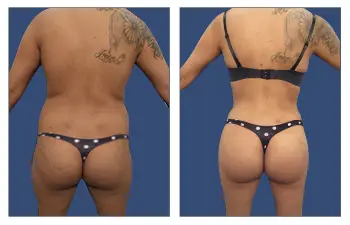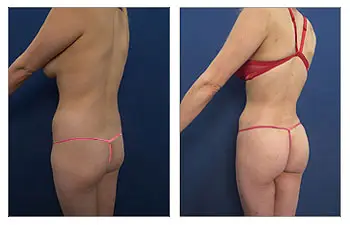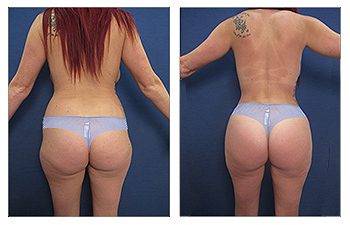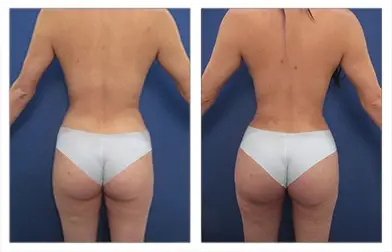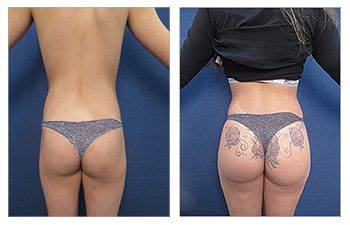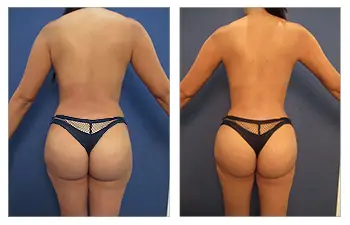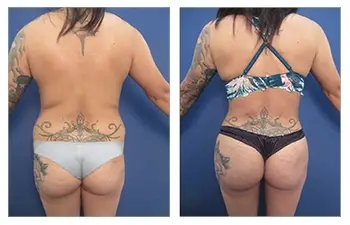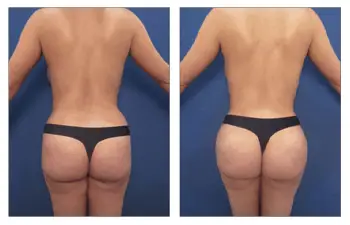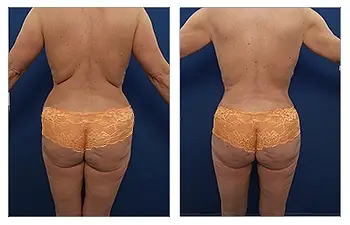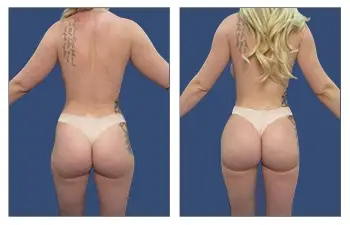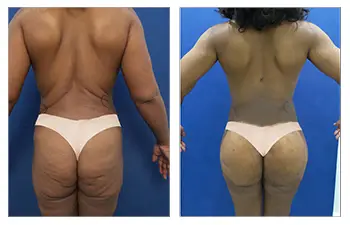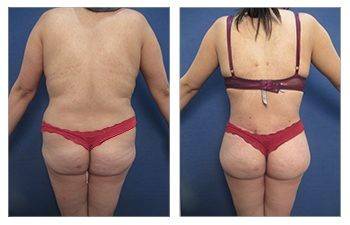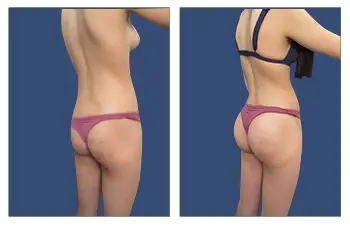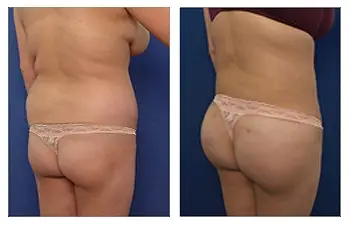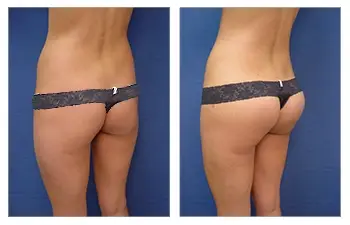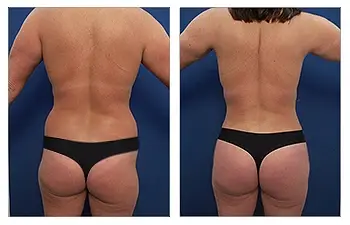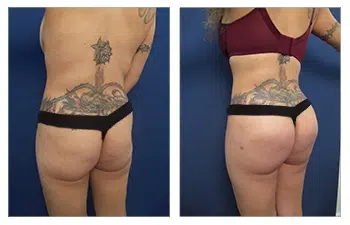Introduction: Pancake Butt
Pancake butt, also known as flat butt, underbutt, gluteal amnesia, or dead butt syndrome, can be caused by a variety of factors. Genetics plays a major role in determining the shape and size of a person’s buttocks. Some people may be predisposed to having less muscle mass in their glutes, leading to a flatter appearance. A sedentary lifestyle and poor diet can also contribute to the development of pancake butt, as the lack of physical activity and proper nutrition can result in decreased muscle tone and overall body fat.
Aging is another significant factor, as the natural loss of fat and muscle mass that occurs as we get older can lead to a flat derriere. In particular, post-menopausal women often experience a reduction in estrogen levels, which can further contribute to a decrease in muscle and fat in the buttocks. Additionally, pregnancy can also change the shape of the butt, as the body undergoes significant physical changes during and after childbirth.
In summary, pancake butt can result from a combination of genetic predisposition, sedentary lifestyle, poor diet, aging, and the physical changes associated with pregnancy. The loss of fat and muscle in the butt can lead to a less shapely and less defined appearance, particularly in post-menopausal women.
What Causes a Pancake Butt?
A pancake butt, or flat buttocks, can be caused by a combination of factors such as genetics, lack of exercise, improper posture, and muscle imbalances in the glutes. Understanding the causes of a pancake butt can help individuals take proactive steps to prevent or address this issue. By incorporating targeted exercises, correcting posture, and making lifestyle changes, it is possible to improve the shape and strength of the glutes and achieve a more rounded and lifted appearance. Let’s explore the common causes of a pancake butt and how to effectively address this condition.
Are Your Jeans Giving You Pancake Butt?
1. Levi’s Women’s 721 High Rise Skinny Jeans: These jeans feature a high rise and a skinny cut, which helps lift and shape the buttocks. The fabric is stretchy and firm, providing support and enhancing the natural curves of the body.
2. Fashion Nova Women’s High-Waisted Jeans: These jeans have a high-waisted design that helps lift the buttocks and create a more defined shape. The fabric is also designed to enhance firmness and avoid the dreaded pancake butt.
3. American Eagle Women’s Super High-Waisted Jegging: The super high-waisted design of these jeggings provides extra support and lift to the buttocks. The stretchy fabric helps to sculpt and enhance the shape of the underbutt.
4. Good American Good Curve High Waist Jeans: These jeans are designed with a high waist and a contoured waistband to lift and accentuate the buttocks. The fabric is also designed to provide maximum stretch and firmness.
5. Spanx Distressed Skinny Jeans: These skinny jeans feature a shaping waistband and strategic stitching to lift and shape the buttocks. The fabric provides firmness and support, creating a more lifted appearance.
When choosing jeans, look for high-waisted or super high-waisted designs, contouring waistbands, stretchy and firm fabrics, and strategic stitching to enhance the shape of your buttocks and avoid pancake butt.
Fat Butt Vs. Muscle Butt
The key differences between a fat butt and a muscle butt lie in their shape, firmness, and overall composition. A fat butt is characterized by excess adipose tissue, resulting from a diet high in calories and low physical activity. On the other hand, a muscle butt is the result of regular exercise, specifically targeting the gluteal muscles, combined with a well-balanced diet. The gluteal muscles play a crucial role in shaping the buttocks, with a strong and developed muscle contributing to a firm and lifted appearance.
Fat and muscle loss can lead to the dreaded “pancake butt,” where the buttocks appear flat and saggy. In contrast, specific exercises such as squats, lunges, and hip thrusts can help to firm and lift the butt muscles, preventing the loss of shape and firmness. Additionally, a diet rich in protein and essential nutrients can aid in muscle growth and maintenance.
In summary, the impact of exercise and diet on buttock shape and firmness is significant, with targeted exercises and a balanced diet playing key roles in achieving a toned and muscular butt.
How to Correct your pancake butt with conservative measures
Are you looking to improve the appearance of your flat or “pancake” butt without resorting to invasive measures? Several conservative and non-invasive methods can help to enhance and lift your buttocks. By incorporating specific exercises, adjusting your diet, and using supportive clothing, you can work towards correcting and toning your pancake butt naturally. These simple measures can help you achieve a perkier and more sculpted rear without the need for surgery or other drastic interventions. Read on to learn about these conservative measures and start your journey towards a firmer and more shapely behind.
Cardiovascular Exercise
Cardiovascular exercise is an essential component of any workout routine, as it helps improve heart health, stamina, and overall fitness. Some of the best cardiovascular exercises to incorporate into your workout routine include running, cycling, and stair climbing.
For running, it is important to gradually increase intensity and mileage to avoid injury. Start with shorter distances and low intensity, then slowly increase the distance and intensity as your fitness level improves. This can be done by adding an extra mile to your run each week or incorporating interval training to increase speed and endurance.
Cycling is a great low-impact exercise that offers the benefits of cardiovascular exercise without putting too much strain on the joints. It is important to adjust the resistance on the bike to gradually increase the intensity of the workout.
Stair climbing engages the gluteal muscles, calves, and thighs, making it an excellent lower-body workout. To increase intensity, try taking the stairs two at a time or adding ankle weights for an extra challenge.
Incorporating these cardiovascular exercises into your workout routine will help improve your overall fitness and contribute to a healthy lifestyle.
Diet and Nutrition
To build and maintain muscle mass, it is essential to include a variety of foods rich in lean protein, healthy fats, and complex carbohydrates in your diet. Lean protein sources such as chicken, fish, turkey, and legumes are crucial for muscle building. These foods provide essential amino acids that are the building blocks of muscle tissue. Additionally, healthy fats from sources like avocados, nuts, seeds, and olive oil are important for providing long-lasting energy and supporting overall health.
Incorporating complex carbohydrates such as brown rice, quinoa, sweet potatoes, and whole grain bread, and pasta into your meals can provide the energy needed for intense workouts and recovery. These carbohydrates also contain fiber, vitamins, and minerals that are essential for overall health. It is important to have a balanced diet that includes all of these essential nutrients to support muscle growth and recovery. By including a variety of lean protein, healthy fats, and complex carbohydrates in your meals, you can ensure that your body has the building blocks it needs to support your fitness and muscle-building goals.
Butt-Specific Exercises
To effectively target the glutes and increase cardio, utilize the Stairmaster as a beneficial exercise. Start at a comfortable speed and stand straight up, emphasizing the importance of core stabilization. Avoid leaning on the handrails to maximize the benefits for the glutes and core, ultimately increasing the capacity and effectiveness of the workout. The Stairmaster provides an excellent opportunity to work on both glute development and cardiovascular endurance while also focusing on core stabilization, making it a versatile and efficient exercise for overall lower body strength and fitness.
Consistency and Patience
Consistency is key in building a firm, round butt. To maintain consistency, it’s important to stick to a regular workout routine that focuses on exercises targeting the glutes, such as squats, lunges, and hip thrusts. Incorporating these exercises into your routine at least 3-4 times a week will help to build and strengthen the muscles in the buttocks.
In addition to a regular workout routine, maintaining a healthy diet is crucial for muscle building. Eating a balanced diet that includes plenty of protein, complex carbs, and healthy fats will provide the necessary nutrients for muscle growth and repair. It’s important to fuel your body properly to see results and maintain overall strength and health.
While it’s natural to want immediate changes, it’s important to stay patient and trust the process of muscle building. It takes time for muscles to grow and strengthen, so it’s important to stay committed to your routine and not get discouraged if you don’t see immediate changes. Consistency and patience are key to achieving long-lasting results and a firm, round butt. Trust the process and continue to approach your fitness goals with a consistent and patient mindset.
How to Correct your pancake butt with surgery
If you have been unhappy with the appearance of your buttocks and would like to achieve a fuller and rounder shape, you may consider undergoing a surgical procedure known as a Brazilian Butt Lift. This popular cosmetic surgery option has been helping patients achieve more shapely and voluminous buttocks, and it may be the solution to correcting your pancake butt. This article will discuss the details of the Brazilian Butt Lift procedure, including the process of fat grafting and the recovery process, so you can make an informed decision about whether this surgery is right for you.
BBL for pancake Butt
A Brazilian Butt Lift (BBL) can benefit individuals with pancake butt by increasing glute strength, stability, and power. The procedure involves transferring fat from other areas of the body to the buttocks, which not only adds volume and shape but also helps to enhance muscle function. The added volume can restore lost curves and contours, addressing the issue of pancake butt and creating a more lifted and youthful appearance.
During the BBL procedure, fat is harvested from donor areas such as the abdomen or thighs through liposuction and then injected into the buttocks to create a more shapely and rounded silhouette. The recovery period for a BBL typically involves some discomfort and swelling, but most patients can return to normal activities within a few weeks. Results are usually noticeable immediately, with outcomes becoming more apparent as swelling subsides.
In summary, a Brazilian Butt Lift is an effective way to not only restore lost volume and shape to the buttocks but also to increase glute strength, stability, and power, providing a more sculpted and lifted appearance for individuals with pancake butt.
Buttock Tuck for Pancake butt
A buttock tuck is a surgical procedure that can effectively address pancake butt by lifting and tightening the buttocks, creating a more rounded appearance. This procedure is beneficial for individuals looking to enhance the shape and contour of their buttocks. By removing excess skin and fat and repositioning the tissues, a buttock tuck can provide a more lifted and youthful appearance.
During the buttock tuck procedure, an incision is made along the top of the buttocks, and excess skin and tissue are removed. The remaining tissue is then lifted and reshaped to create a more rounded and lifted appearance. The recovery process typically involves wearing a compression garment and avoiding sitting or lying on the buttocks for a certain period. Risks and complications may include infection, scarring, and changes in sensation.
There are different options available for buttock tuck surgery, including the use of implants or fat grafting. Non-surgical alternatives such as injectable fillers or buttock-enhancing exercises can also be considered for those who prefer a non-invasive approach to achieving a more lifted and rounded buttock appearance.
How to Turn Your Pancake Butt into a Rounded Wonder
To perform bottom-firming workout routines targeting the underbutt and building muscle mass and firmness, start with exercises such as squats, lunges, deadlifts, and hip thrusts. These exercises engage the glutes and hamstrings, helping to sculpt and strengthen the underbutt area. Aim for higher reps and lower weights to build muscle endurance and definition.
For those looking for a next-best solution to transform a pancake butt into a rounded wonder, a precision-engineered Brazilian butt lift (BBL) can be an option. This procedure involves transferring fat from other parts of the body to the buttocks, creating a more rounded and lifted appearance. However, it’s essential to consult with a qualified plastic surgeon to discuss the safety and effectiveness of this procedure.
Practical tips for building a firmer, rounder, and more lifted derriere include maintaining a balanced diet, staying hydrated, getting enough rest, and incorporating both strength training and cardio into your workout routine. Focusing on proper form and technique during exercises is also crucial for targeting and activating the underbutt muscles effectively. Remember to be patient and consistent with your efforts, as progress takes time and dedication.
Conclusion: Pancake Butt
In conclusion, addressing a pancake butt requires a comprehensive approach that includes regular bottom-firming workouts, a well-balanced diet rich in protein, and avoiding prolonged periods of sitting. Genetics, a sedentary lifestyle, poor diet, aging, and pregnancy can all contribute to the development of a flat butt. Genetics can play a significant role in the overall shape and size of a person’s buttocks. Sedentary lifestyles and poor diets lacking in protein can lead to decreased muscle mass and tone in the buttocks.
As we age, our bodies naturally lose muscle mass and elasticity, leading to a flatter appearance. Pregnancy can also cause the buttocks to flatten due to hormonal changes and weight gain. By incorporating bottom-firming exercises into a fitness routine, maintaining a balanced diet with sufficient protein intake, and avoiding prolonged sitting, it’s possible to combat the development of a pancake butt and achieve a more shapely and toned appearance.

